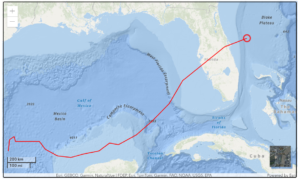Water levels in parts of the Ohio and Mississippi rivers are likely to reach critically low stages soon, forcing shippers to light-load harvest-season grain barges for the fourth year in…
Florida Citrus Hit by Hurricane Milton
Bloomberg’s Ilena Peng reported that “oranges and some citrus trees are lying useless on the ground in Florida’s groves after Hurricane Milton tore through the state, setting back growers just as they hoped the worst for the struggling industry was over.”
“The powerful storm moved through key citrus-producing counties after making landfall in Florida (last) Wednesday night, killing at least a dozen people,” Peng reported. “While it wasn’t as destructive as many feared, the hurricane came at the worst possible time for citrus farmers. Not only did it arrive just ahead of the all-important harvest season, it delivered yet another blow to an industry that was just seeing the glimmers of a turnaround.”

“Progress had been made in combating a deadly citrus disease called greening that has decimated orange production,” Peng reported. “Groves were recovering from Hurricane Ian two years ago, after crawling back from Hurricane Irma in 2017.”
Production Estimates Show Smaller Crop
Fox Weather’s Andrew Wulfeck reported that “new estimates from the U.S. Department of Agriculture show that Florida’s citrus crop was struggling before Hurricane Milton, with the cyclone expected to further exacerbate the challenges that growers now face.”
“According to the agency’s October survey, harvesters are expected to produce only 15 million boxes of oranges during the 2024-2025 season—a figure that represents a decline of about 16 percent from just a year ago,” Wulfeck reported. “This estimate was calculated before Milton impacted west-central Florida as a Category 3 hurricane, affecting some of the state’s largest citrus producers.”
MarketWatch’s Myra P. Saefong reported that “Florida’s orange production has dropped by an estimated 92% in 20 years, according to the U.S. Department of Agriculture, attributing the loss to natural disasters, such as freezing and hurricanes, and disease such as citrus greening.”
“‘Global supplies have also been ‘constrained,’ said (Matt) Joyner, (executive vice president and chief executive officer of Florida Citrus Mutual),” according to Saefong’s reporting. “Brazil has been dealing with citrus greening, which the U.S. has been also dealing with for roughly the last two decades, he said, referring to the disease, which leads to a decline in crop, as the world’s worst known citrus disease. Brazil’s production has been down quite a bit due to natural disasters too, so it is a ‘global phenomenon’ that we’re seeing in the juice market that’s reflected in the futures price.”
Full Extent of Damage Still Being Assessed
Saefong reported that “it’s too early to know the extent of the damage, but there’s a ‘significant amount of fruit on the ground’ from hurricane-force winds and with a tree crop, you can continue to see in the next week to two weeks ‘additional drop,’ (Matt Joyner) said. The early orange harvest began this past week so a lot of those fruits were heavy and starting to reach maturity, so were much ‘more susceptible to the impacts of wind.'”
Peng reported that “full damages from Milton are still being assessed, but past storms provide some indication of the severity of impacts to groves. The state’s production dropped more than 60% in the 2022-23 season after Hurricane Ian swept through, causing nearly $250 million in estimated citrus losses. Output dropped by more than a third after Hurricane Irma in 2017.”





